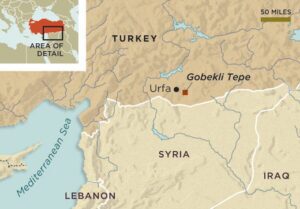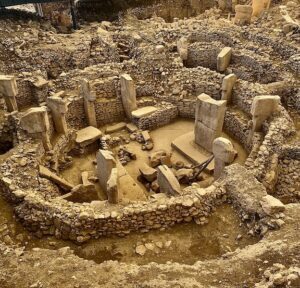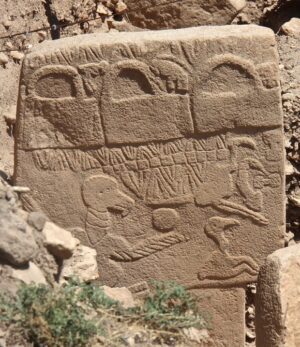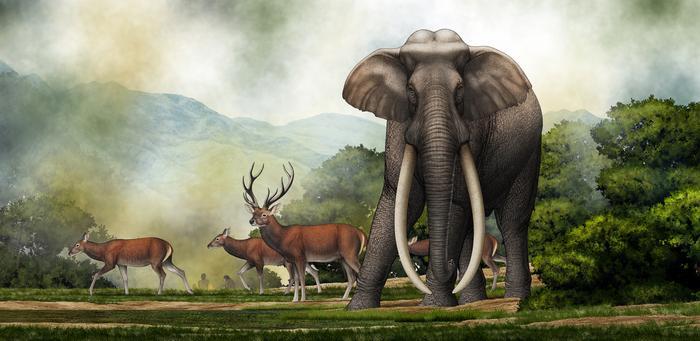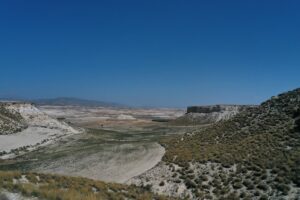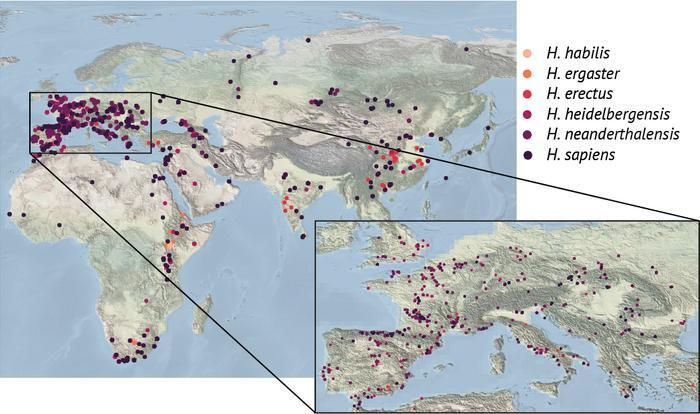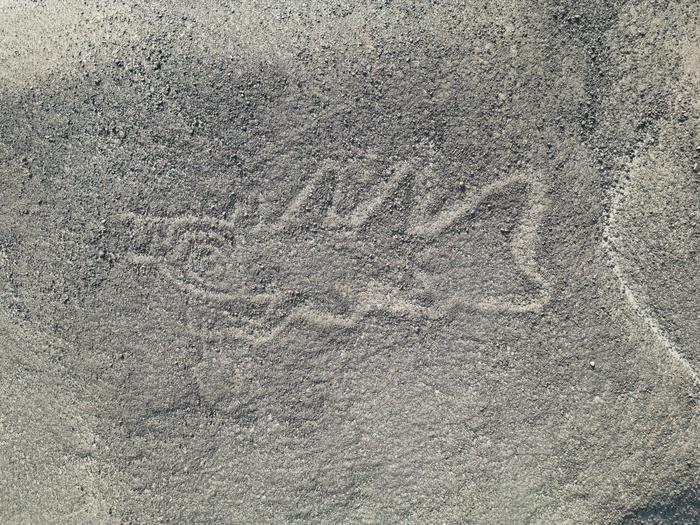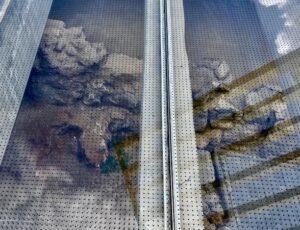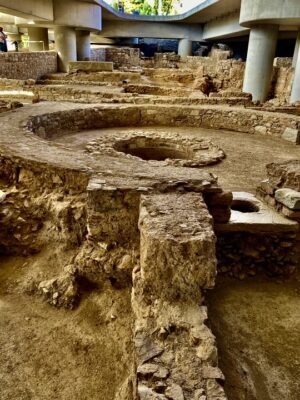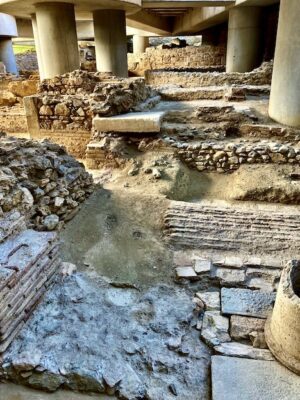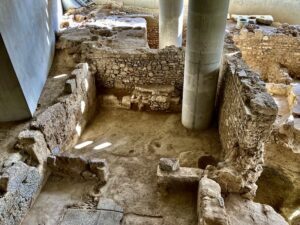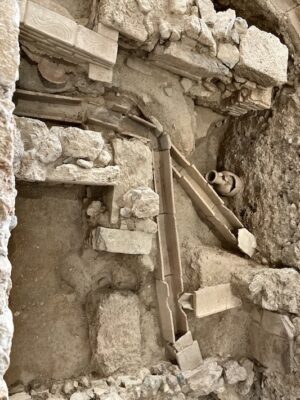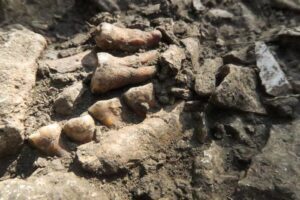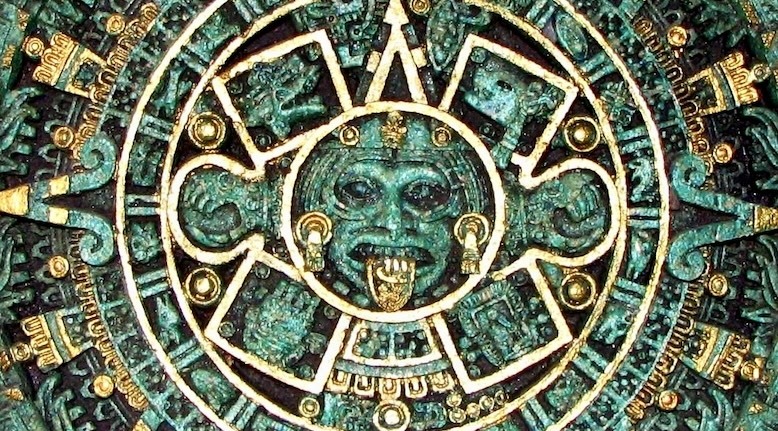
It was dark, for there was no Sun when the gods met. They said, “who will bring the Sun?” After the fall of the Fourth Sun, “all was darkness, there was no Sun” (Leyenda de los Soles, 1558). There have been five suns or ages, each unique and unrepeatable. The first was the Age of the Earth, followed by the Age of Great Winds, the Age of Fire, the Age of Floods, and the present age of Earthquakes. The first four conform with the four elements: earth, air, fire, and water. To each age one of the five cardinal directions was assigned, locking the Otomi and later Aztec spiritual structure of space into that of time (Brundage, 1979:27). The first four suns were imperfect and ended in collapse, the fifth is the present one and there will be no more. In the Nahuatl language, the name of the Fifth Sun, and the beginning of the current era is called 13-Reed, equivalent to the year 1479 in the modern calendar. Taken together the cycles of the suns make up the complete history of time, of gods, of man, and the epic of creation. All of this is finely carved on the twenty-five-ton Sun Stone now in Mexico City’s National Museum of Anthropology and History. The Sun Stone is not a calendar but a calendrical reference to the cyclical concepts of time in relation to cosmic conflicts in Aztec ideology (Kelin, Cecelia F., 1972) .
_______________________________

Nam Ollin, the Sun Stone @georgefery.com
_______________________________
Let us focus here on the symbols carved at the center of the monolith, which depict Tonatiuh’s face, the Fifth Sun deity, whose tongue takes the form of the sacrificial knife, the tecpatl. On each side of the face are two clawed hands holding a human heart, synonymous with both life and the sun god’s rule over it. The four small circles above and below each of the clawed hands are Ollin symbols denoting the movement of the Fifth Sun (Nam Ollin). Each of the four squares that surround the center are glyphs of the previous four suns or eras. At the top right is “Four Jaguar” (Nahui Ōcēlotl), when the first era ended. The top left is “Four Wind” (Nahui Ehēcatl), when the hurricane winds destroyed the earth. Bottom left is “Four Rain” (Nahui Quiyahuitl), when earth was destroyed by continuous fires. At the bottom right is “Four Water” (Nahui Atl), an era that ended when the world was flooded. Furthermore, the glyph 4-ollin is symbolic of hule, a natural elastic substance from tropical plants that was used to make balls for games. It suggests that, without constant impulse by players, a ball will slow and eventually stop—like the fourth sun did. Of note to those unfamiliar with ancient cultures, there is no barrier between myths and reality. They are one and the same.
_______________________________

The Sun Stone’s Core @georgefery.com
_______________________________
Two cities loom large in Aztec mythology: Teotihuacán and Tula in central Mexico.The first overwhelmed the ancient Toltecs, upon whom they imposed their social and religious culture, while Tula cast its spell over the ogled-eyed Chichimecs. The legends relate that once at sunrise, in the Chihuahua desert of northern Mexico, seven Chichimec groups came out of Aztlan, their legendary seven caves at Chicomoztoc. This mythic world was the birthplace of the Aztecs, also called Mexicas, together with the Tepanecs, Acolhuas and four other nahuatl-speaking groups who migrated toward central Mexico in the eleventh-to-twelfth century. On their way south, while camping on a stream, arguments arose among group leaders as to the way to a better life. At the height of the argument, under a blue sky, a bolt of lightning struck a large tree under which they had gathered, splitting it in half. This event was understood as a command from the gods that prompted the dissidents to head out their separate ways.
______________________________

Chicomoztoc Seven Caves @arqueologiamexicana.mx
______________________________
They all spoke the nahuatl language. Scholars point out that it was the Toltecs who enriched the mythology and added to the Chichimec stock of gods the all important figures of the four Tezcatlipocas, each of which presided over one of the four cardinal directions and their attendant deities. The gods’ precondition for their benevolence, however, required sacrifices and the shedding of blood. But why? Self-inflicted or collective spilling of blood was common in Mixtec, Aztec, Maya, and other Mesoamerican religions. Miller and Taube underline that since gods gave their blood to create humans it was understood that human blood was the utmost gift to the gods, thus asserting a mutual dependence. Blood, therefore, spilled through self-inflicted wounds, shed on the sacred stone (techcatl), collectively in war or for religious events, was believed to feed the gods’ demands to renew the original bond with humans and their divine food. (1997:46).
There are many legends and myths about Huitzilopochtli’s birth, among which is the one that tells the story of his mother Coatlicue, (the Earth), who was impregnated by receiving a ball of humming-bird feathers on her chest, which she put in her apron while attending duties on Mount Coatepec or Serpent Hill, near Tula. Among her children were the four hundred Centzon Huitznahua related to countless stars in Aztec mythology. Their sister Coyolxauhqui (the Moon) furiously demanded that her mother reveal the father’s name. The mother refused, so, angered by her perceived deceit and with her brothers, Coyolxauhqui decided to kill her. The mother was frightened but Huitzilopotchli (the Sun in her womb) told her not to fear. When the brothers, the stars, and their sister the Moon launched their attack, the Sun burst forth from his mother’s womb fully grown wearing his magic battle gear. He fiercely counter-attacked, beheading his brothers and sister, whom he cut into pieces. He then cast the body parts down from Coatepec’s hilltop, drenching the Serpent Hill with blood. Coyolxauhqui is shown, hacked to pieces by her brother, on the carved round massive stone that bears her name found in 1790 at the bottom of the steps of the god’s great temple.
In this mythic worldview the Sun is perpetually battling the Moon and the stars underlining the Aztec’s unquenchable need for human blood to foster the Sun’s sustenance. Huitzilopochtli was said to be in a constant struggle with the darkness and required nourishment in the form of sacrifices to ensure the sun would survive the cycle of fifty-two-years, which was the basis of many Mesoamerican myths.
_____________________________

Coyolxauhqui’s Stone @georgefery.com
_____________________________
Urged by Huitzilopotchli, for over two hundred years, the Chichimecs battled their way from Chicomoztoc to the central plateau of Mexico by way of Tula. Famine and wars between 1070 and 1077 led to the social breakdown of the Toltec culture and their migrations from Tula to other parts of Mesoamerica in the twelfth century. Much of Tula’s history was lost when the Aztec Tlatoani Itzcoatl (1427-1440), burned the Toltec codices. Prompted by Huitzilopotchli on their long trek, the Aztecs overcame adversity and the tenacious hostility of many people, whose lands they crossed or dwelled for a time, and kept heading south over ancient trade routes. In spite of hardships and setbacks, time-and-again they were prodded by their god to move further south, with the promise of a great future. Their persistence paid off, for they ultimately settled on muddy islets on Lake Texcoco’s shores on the central plateau of Mexico, a place they would call their own.
The Crónica Mexicayotl (1610) tells us that the eagle on a prickly pear cactus (nopal) holding a tuna in its claws is allegorically the image of the sun feeding from the hearts of sacrificial victims, which proclaimed Aztec power through human sacrifice (Duverger, 2007, 554-555). There are many versions of the eagle holding a bird or a snake. In this last case, Huitzilopotchli told the Mexica searching for a home, to look for an eagle on a prickly pear cactus devouring a snake, a depiction now shown on the coat of arms of the Republic of Mexico.
As Huitzilopotchli promised, the grand priest Tenoch drew the footprint of the Aztec capital in 1325. Within a few years and hard work of landfilling the shallows of the muddy islets and lake shores with rocks and earth, they gained firm ground. Despite their neighbor’s repeated attempts at defeating them, such as those of Tacuba, Culhuacán and others on the lake shores, in little less than a century the city master plan, drawn by the high priest Tenoch, grew to cover six square miles and would become the most important in Mesoamerica. It housed over 150,000 inhabitants in four large districts (calpullis), which were socio-cultural units that shared the nahuatl language, beliefs, and customs. Five dikes were built to link other towns on the shores of the lake, along with a large aqueduct that channeled fresh water from a source on Chapultepec Hill. According to Franciscan friar Bernadino de Sahagún (1499-1590), seventy-eight large buildings were erected in the city’s ceremonial center. Among them was the Great Temple (Templo Mayor), a depiction of the sacred mountain of Aztec mythology with the twin temples of the gods Huitzilopotchli and Tlaloc at its top.
_____________________________

Tenochtitlan, 15th Century @georgefery.com
_____________________________
Of note is that in the cultures of the Americas there were gods for everything; they were everywhere, visible or invisible. The gods of nature – from mountains to lakes and oceans, the weather, and the animal world – were beyond numbers. Nighttime gods were attached to myriads of stars. In war, victors would adopt the gods of the vanquished, and vice versa, and it was common to temporarily loan or borrow a god from neighbors. Of course, gods never died. The Aztecs adopted many gods from past cultures, particularly those commanding the alternance of day and night, from which arose the legend of the Fifth Sun (Nahm Ollin), incorporating parts of Toltec creation myths while introducing new ideas to support the Fifth Sun allegory.
The legends of the Suns tell us that the Fifth Sun arose over Teotihuacán, the “City of the Gods” thirty miles from Tenochtitlan (Mexico City today). It recounts that Tecuciztecatl, the son of Tlaloc and Chalchiuhtlicue, was called by the assembled gods to rekindle the Sun. The world was then in an unending darkness, so the gods cried, “Who will carry the burden of rekindling the Sun and bring dawn through sacrifice?” For lives were required by ancient gods as payment for having created humans. Tecuciztecatl volunteered to be the first sacrificial victim; the assembled gods then called the humble deity Nanahualitzli as second, and he agreed to their demand. On a large platform facing the monumental Pyramid of the Sun at Teotihuacán, the gods prepared an enormous sacrificial pyre that burned for over four days while the rituals and penances of the two volunteers took place. At midnight of the fourth day while the pyre burned fiercely, the gods called Tecuciztecatl to jump into the fire to burn and rise as the Sun; Nanahualitzli would then follow and rise as the Moon. Four times Tecuciztecatl ran to the pyre but was held back by the fierceness and heat of the flames. The gods then called Nanahualitzli who, without hesitation, calmly walked and jumped into the fire. Slowly as he burned, dawn lightened the sky. Tecuciztecatl, seeing the heroic death of Nanahualitzli, followed into the pyre, was consumed by the fire, and rose as the Moon. Re-energized, Tonatiuh the fiery Sun god, became the warrior sun harboring, from rise to zenith, the souls of those who died in battle and from zenith to sunset, the souls of women who died in their first childbirth.
This creation story reinforced the belief that the Fifth Sun demanded repeated shedding of human blood on the sacrificial stones of Tenochtitlan temples.
____________________________

Teotihuacán, Pyramid of the Sun @ Mario Roberto Duran in wikipedia.org CC BY-SA 4.0
____________________________
The Mexica or Aztec empire was governed by two prominent figures, the Tlatoani and the Cihuacoatl. The Tlatoani was an autocrat whose absolute civil and spiritual powers ruled the male domain and the sky deities, among which was Tezcatlipoca. Second to the Tlatoani, the Cihuacoatl, who was spiritually associated with the namesake goddess of childbirth, was the “esteemed advisor” to the Tlatoani and ruled Tenochtitlan.
The reference to Cihuacoatl in his title underlines the nature of duality shared between both leaders that pervaded Aztec worldview and spiritual life. It was Tlacaelel who reformed the Aztec religion and put Huitzilopochtli at the same level as Quetzalcoatl, Tlaloc, and Tezcatlipoca, making him a solar god. Huitzilopochtli then replaced Nanahualitzli, from the Nahua legend. In 1428 the Cihuacóatl was Tlacaelel, a well-born noble with a sharp mind. Together with Netzahualcoyotl (the Tlatoani of Texcoco) and Totoquihuatzin (lord of Tlacopan), he was the architect of the Triple Alliance (1428-1521), which began a round of conquest that, in less than a century, would encompass a vast territory with over four hundred cities and towns. The Triple Alliance greatly expanded Aztec political, economic, and military dominion over central Mexico, south to the isthmus of Tehuantepec and beyond to today’s Guatemala.
Many city-states (atlepetl) within the alliance were fiercely independent, with their own customs and languages. The two-fold Aztec objective was political domination and control of resources for economic growth and expansion of the state. An allied city-state supplied manpower and resources to Tenochtitlan while in return the central government gave local governments military protection and articles or products that would otherwise be unattainable. War also provided slave labor for state building projects and sacrifices for religious ceremonies, for temple priests wanted to be paid with sacrificial lives for their support. The Aztecs’ efficient military structure and power projection in the region grew rapidly, which allowed for daily supply of goods and services carried to the power center from allied and conquered cities.
______________________________
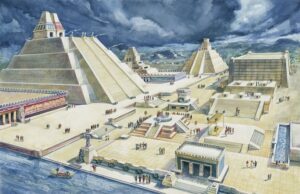
1487 Tenochtitlan Great Temple @discoverymagazine.com
______________________________
Every Aztec male twelve to fifteen years old received basic education and military training in their schools (telpochcalli). The army was a major opportunity for upward social mobility through success on the battlefield, particularly for commoners (macehualtin). For this reason, the expectations of nobles (pipiltin) and commoners alike, revolved around war, which became the driving force of their society and its policies. Shortly after taking office, a Tlatoani had to show his ability as a warrior. His first campaign would make it clear to subject polities that his rule would be as tough on any rebellious conduct as that of his predecessor. Should his first military campaign be a failure, it would be seen as a very bad omen for his rule and could lead to rebellions of city-states (atlepetl).
The troops were made up of common men who were not paid for their service which was regarded as tribute labor to the state. The local civil representative (tlatocayotl) from each district led the troops. Officers were trained in the university (calmecac) and came from the nobility. Their weapons were clubs lined with sharp obsidian stone blades (macahuitl), deadly dart throwers (atlatl), bows, clubs, and knives. Nobles had benefits attached to their social status, among which was their protection on the battlefield by battle hardened Eagle and Jaguar warriors. The political and economic contributions to the state were important. However, they were not always the primary goal for war. Besides its purpose for defense and maintaining socio-political and economic order, war was foremost the purveyor of victims for sacrifices to the god of war Huitzilopochtli and to the god of rain, Tlaloc and a swarm of other deities.
The Aztecs incorporated parts of other Mesoamerican myths while they introduced new ideas to support the Fifth Sun allegory. To understand from where these demanding gods came, we need to briefly visit the dawn of humanity. The anthropological record tells us that then men were tasked to hunt and protect the group. Women’s roles, beyond that of caring for children and older family members, were to attend to the sick and the maimed. Older men and women were then tasked to search for edible plants and select those that would help in curing illnesses and wounds. Through time, trial and error, mind-bending substances derived from plants were singled out for medicinal purposes. In the Americas, Ayahuasca (Banisteriopsis caapi), Peyote (Lophophora williamsii) and cannabinoids (Cannabis indica), among many, were used to alleviate pain, and later to attain visions that opened the mind to a singular world of uncommon human and animal-like shapes. The reflections from altered consciousness, however, were associated with reality for the figures of those singular beings carried the same familiar traits as those of the living, such as deceit, anger, duplicity, and desire. As Allegro notes “…for such a glimpse of heaven men died…while great religions were born, shone as a beacon to men struggling still in the unequal battle with nature, and then they too died, stifled by their own attempts to perpetuate, and codify the mystic visions” (1970).
Sacrifices to the beings of this “other world,” shamans said, were the requisites to make sense of a hidden and unpredictable nature. Foremost, however, human sacrifice was grounded in the belief of a debt that must be paid back to the gods for creating humans and everything on earth necessary for their daily sustenance (Graulich, 2003:17). Each aspect of life, in the Aztecs mind, revolved around this debt that must be paid to gods and deities with gifts from the fruits of the land and sacrifices of wild and later, domesticated animals. This commitment to paying the debt of life had many ritual and theological dimensions. Eventually, the welfare of the living required them to feed these insatiable man-made gods with human lives. In smaller towns with no monumental architecture, gods received sacrifices through their earthly depictions made of wood, paper, or stone called ixiptla. Upon sacrifice, a victim’s blood was collected in a ceramic or stone bowl in which soft paper was soaked and used to swipe the eyes, mouth, and face of a select deity’s likeness (ixiptla), while at the same time, pleading for its help or mercy.
To answer their gods’ demands, the Aztecs slayed people on a massive scale. At least seven types of human sacrifices took place, among which were heart extraction, shooting with arrows, gladiatorial combat, beheading and offering children to the gods. We will limit our inquiry to three of them. Ancient texts relate the birth of human sacrifice at Teotihuacán, a ritual borrowed by the Toltecs at Tula, and named the god Tezcatlipoca as its generator. In Tula’s last days (1150), Tezcatlipoca taught people to sacrifice those captured in war. The historical record show that the Aztecs acquired the cult of human sacrifice from the Toltecs, which would explain why it was adopted as a dogma, for the gods had originated it and the venerated Toltecs passed it on. As inheritors of such long held beliefs the Aztecs could not conceive of gods and their welfare without human sacrifice for only then could men be beholden to the supernatural order (Brundage, 1977:32). Most of the ceremonies involving such sacrifices were associated with the 365-day solar calendar and the 260-day sacred calendar. The solar celebrations were especially important, for they recreated various ritual aspects of the Mesoamerican cosmogony such as the rise of the Sun and its rekindling via human sacrifice. These agrarian celebrations took place monthly and were related to the eighteen month calendars such as, planting, harvesting, equinoxes, and solstices, among others. Natural events were understood to be governed by an unpredictable nature in the hands of gods, among which were Chicomecoatl, goddess of agriculture, and Xilomen deity of the main food staple, maize.
_____________________________

Seven Souls @PierreFritel artworks in commons.wikimedia.org
_____________________________
Foremost among sacrificial donations was the human heart (tona), seat of the teyolia that moderns call the soul. It was believed to be a fragment of the sun’s fire (istli), the invisible seed of life that never dies. The instrument of sacrifice, the nahui tecpatl, was a knife divinized as a god, the implement of the Fifth Sun, used for heart extraction. It was a short six-to-eight-inch-long flint or obsidian double-edge blade with, for important ceremonies, a mosaic crouched figure of a god on the handle. The carved image shows circular plugs in its ears and a bow ornament made of feathers associated with Tonatiuh the Sun god; the figure’s hands appear to hold the knife’s blade. After a sacrifice, the water from cleaning the blood-encrusted blade and handle, was believed to produce a magical drink mixed with peyote (Lophophora williamsi), a psychoactive drug that was believed to make one contemptuous of death. Such a mixture was given to Eagle and Jaguar warriors going off to battle, and to noble captives led to the techcatl, the sacrificial stone. Standing about three to four feet high, and two feet or so wide with a sloped top upon which a captive was firmly held on his back. It stood about a foot from the front edge of the upper terrace of a pyramid so that the lifeless body could easily be tipped off to tumble down to the pyramid threshold, the apetlatl. “Heart extraction was a common form of sacrifice and was one of the most dramatic and grisly skills ever created by the imagination of man. The subject is unpleasant but, without at least a cursory knowledge of this practice, one can never know the Aztecs” (Brundage, 1979:215).
The sacrificial victim was forcefully brought up the pyramid’s steps by strong temple guards. On the Great Temple upper terrace, facing Huitzilopoltchli, the victim was met by the high priest and the priest-executioner. He was then forcefully stretched and held spreadeagled on his back on the techcatl by temple attendants (calmecacs). For religious sacrifices six souls were tasked to help release the seventh through the pain of deliverance. They were the five temple attendants, who each held the victim’s arms, legs, and head, the executioner was the sixth, and the sacrificed, the seventh soul. This symbolic order answered to the four Tezcatlipocas, lords of the four cardinal directions, together with those of the zenith and the nadir, with the victim on the techcatl at their intersection. Prayers and singsong incantations to the gods were attended with a low drumbeat.
Upon completion of invocations, the priest-executioner holding the sacrificial knife (nahui tecpatl), cut a deep eight-to-ten-inch lateral gash below the ribs on the left side of the rib cage. The screams of fear and pain coming from the victim were believed to please the deity. The priest then forcibly put his hand in the gash and, seizing the beating heart, ripped it out of the chest. The blood from the severed aorta and arteries gushed forcefully over the priest and his attendants. The high priest then lifted the heart above his head and sung praises to the god to whom the sacrifice was dedicated, attended by now louder drumbeats and conch shell trumpets. The heart, offered to the Sun was then thrown in a carved stone bowl (cuauhxicalli), shaped on the belly of the reclining stone statue of a man leaning on its elbows (chac mool); “later the heart was cooked and eaten by the priests” (Brundage, 1979:217). Once the heart was removed, the body was shoved from the blood-drenched sacrificial stone down the pyramid steep stairway of the pyramid and allowed to tumble to the bottom. There, it was seized by temple guards. The head was cut and taken to join others on the large skull rack (huey tzompantli), a tall rectangular structure erected on the plaza facing the Great Temple. The body was then cut to pieces and select parts were shared in a ritual cannibalistic feast by the captor (tlamanih), his family, and friends; a femur was given to the captor who hung it in his house as proof of his valor.
The skull rack facing the Great Temple was 115 long by 40 feet wide. On its top was erected a forty-plus foot high scaffold of wood poles connected by a series of smaller horizontal section of wooden crossbeams. The skulls had the skin and hair removed, except for those of nobles and army officers. They were then displayed on the tzompantli by punching holes through skull temples where the crossbeam pole was inserted. Display of skulls of war captives and other victims was meant to impress citizens and visitors alike. When the tzompantli ran out of room, old skulls were simply discarded. Why display only skulls and no other body parts? In ancient cultures the head, skull and brain were one and the same. It was perceived as the seat of physiological and emotional vitality, the locus of identity and social status.
____________________________

Chac Mool, Tlaloc Temple @georgefery.com
____________________________
The head was then believed to be the portal to the sacred and to life cycles. The central plateau of Mexico ancient records drawn by local people, point to thousands of sacrifices taking place each year in mid to large urban areas. In Cholula with its unusual number of temples, hundreds were sacrificed annually (Torquemada.II,120 – Acosta, 1962,). The great skull rack structure (tzompantli) in Tenochtitlan’s Great Temple precinct, was flanked by two tall towers in which were embedded hundreds of skulls. Between the towers the enormous lattice work of wood beams held thousands of skulls.
____________________________

Skull Rack, “Tzompantli” @arqueologiamexicana.mx
____________________________
Taking war captives (yaoyotl) was very important to Aztec warriors. For common soldiers, social aspirations were tied to attaining emblematic status of “butterfly” (papalotl) by capturing four enemies for sacrifice, which would result in a promotion to officer rank. All the actors on a battle ground were aware that their foremost aim was to capture rather than kill the opponent. Enemies seriously wounded were dispatched on the spot, while others were taken behind the front line, by dedicated teams. Their hands were tied behind their backs and a wood collar (cuauhcozcatl), was fastened around their neck, and linked to a long rope tied on which other captives (maltin) were also tied. At the end of the battle, every enemy captured was brutally driven to the city limits where he was recorded and credited to his captor. Once inside the city, however, the captives were treated kindly and with deference, because, from this moment on, they were no longer captives or slaves but recognized as full-fledged Aztecs citizens, not foreigners. All their needs were met, and they were offered sumptuous garments, fine food, drink, and women, since as citizens, they were now the god’s properties preordained for sacrifice. For months they paraded in the streets, attended popular events, sang, danced, and were housed in nobles’ quarters. Civil servants, merchants (pochteca) and other notable people bought slaves they donated to their temple for sacrifice to their select deities. The Aztecs could not conceive of gods and their welfare without sacrificing their own, not foreigners, for these gods were their gods, not the gods of others. As noted by Garcia Icazbalceta, “no slaves were taken in the wars of these natives, for they kept them all for sacrifice, and such formed the majority of those sacrificed in the land. Few except those taken in war were sacrificed, for which reason wars were continual” (1824-1894).
Sacrifices increased with time, and Flower Wars (xochiyaoyotl) were dedicated to capture victims in time of peace. These so-called wars did not aim to gain political, military, or economic benefits, but to secure offerings for the gods. The parties fought under a set of agreed upon rules, among which was the presence of an equal number of well-trained fighters on each side. According to Ixtlilxochitl (1500-1550), a lord from Texcoco, the rationale for the Flower Wars arose in response to another enduring crop failure and consecutive famine due to a severe drought (1450-1454). According to Ixtlilxochitl, the high priests of the Triple Alliance, Tenochtitlan, Texcoco and Tacuba said that the flayed one Xipe Totec, the god of nature, was angry, and to placate his ire it was necessary for the affected communities to supply victims. Those, such as in Tenochtitlan, Texcoco, Tlaxcala, Cholula and Huijotzingo, among other cities, were mandated to obtain human sacrifices to appease the gods with lives and especially for the war god Huitzilopotchli, patron of the state. In his old age, Tlacaelel referred to the Flower Wars as a military “fair” or “market,” arguing just as merchants went to distant places to purchase luxuries, the god accompanied the army to the Flower War to purchase the food and drink he coveted. Sacrificed knights were understood to be the god’s food and blood, or the currency with which to purchase food for the deity (Assig, 1988).
The important site of the rain god Tlaloc, beside its sanctuary atop the Great Temple next to Huitzilopotchli’s at Tenochtitlan, was on the Tlaloc Peak (Tlalocatépetl) a 3,500-feet-high mountain on the eastern rim of the Valley of Mexico situated at the end of a forty-four miles road connecting the two places of worship. The Tlaloc Peak is located directly east of the Great Temple, in-line with classic Aztec architecture with sunrise, for the Mexica designed everything to cosmological directions. To appease the gods and deities of the water world and rain destructive forces, babies, and children up to eight years old were sacrificed there during dry periods until rains started. Young children were joyfully carried on open litter to the sanctuary atop the peak. At dawn for the Huey tozoztli celebrations, little boys and girls were decapitated to honor the gods Cinteotl, Chicomecoatl, Quetzalcoatl, and Tlaloc. Sacrifices also included starvation of the little ones when they were left in a small, sealed cave in which they slowly died. (Berrelleza, Torre Blanco – arqueomex. 1998:31). In 1980, in Mexico City’s Great Temple, at the northeast corner of Tlaloc’s temple, “Offering.#8” was uncovered where were found the decapitated remains of thirty-eight children of both genders aged two to seven years, sacrificed at the time of the 1450-1454 famine. Together with the remains were found turquoise disks, a Tlaloc effigy, jade necklaces, and other semi-precious jewels (Duverger, 2007:618). At the time, the depth of beliefs was so deep-seated in people’s mind and heart that it overcame elemental compassion for one’s own. In Mesoamerican cultures, in time of collective crisis, such as persistent droughts and repeated food shortage, a community would sacrifice its best and most cherished, not the sickly or the maimed. Sacrificial victims had to be able, in their prime, and the younger the better, for the gods would not accept anything less.
In other Mesoamerican cultures there were also numerous secular and religious holy days that required human sacrifices believed to pacify the deities of the cosmic order. But they never reached the extent found with the Aztecs. The constant emotional turmoil of endless wars drove common folks to suicide as found in codices, that show people strangling themselves. Were the people moved by deep religious convictions which required them to create public and private elaborate forms of individual spiritual cleansing and penance? A cursory reading of ancient texts in the nahuatl language, as Brundage points out, reveals the terrible anguish and fear of individuals because of offenses against religious or moral laws (1979:186). For this reason, perhaps, collective cleansing events took place at dedicated times.
Prominent in the Aztec spiritual universe was the end of the fifty-two-year calendar round associated with the 260-day sacred calendar (Tonalpohualli), and the 365-day agricultural calendar (Xiupohualli). The two-time cycles together created the 52-year Aztec “century” associated with the putting out and rekindling of fires throughout the empire. At that time, fires on temples and homes were extinguished. Ritual cleansing together with self-bloodletting by parents and children took place in each household. Ceramic bowls and plates, stone jars and cooking utensils were broken, for they were believed to carry the essence of the old cycle. Huehueteotl (aka Xiuhtecuhtlil) the lord of fire, was celebrated throughout the year but especially at the end of the fifty-two year cycles. For Huitzilopochtli was said to be in a constant struggle with darkness and required nourishment in the form of sacrifices to ensure the sun would survive the cycle of fifty-two years, which was the basis of many Mesoamerican myths. At that time, it was believed that the new fire ceremony would forestall the end of the Fifth Sun for it represented the shift from one time cycle to the following. Then, priests marched in solemn procession up the extinct Huixachtlan volcano to wait for Orion’s belt, called “the fire drill”, to rise over the mountain; then a man was sacrificed. The victim’s heart was ripped from his body and a ceremonial hearth was lit in the cavity of the chest using the hand drill method to generate the sacred flame. A large wood pyre was then lit from that flame and torches were carried on pine sticks by runners to light the fires on temples in Tenochtitlan and beyond. The fires were also lit in homes and all family members drew blood anew from their nose or ears, and threw the blood-stained rags into the new fire, the smoke carrying their pleas and hopes to the gods. At dawn, the entire populace of a city or town would go to nearby bodies of water to wash and cleanse themselves of past anguish and despair.
_____________________________

Huehueteotl, God of Fire @georgefery.com
____________________________
It was during the reign of the eighth Tlatoani, Ahuitzol (1486-1502), that sacrifices knew no bounds. Ahuitzol inherited the throne after the short and weak rule of Tizok (1481-1486), who left serious problems unsettled with allies and foes alike, that required swift and forceful resolutions. Reasserting Aztec power was a major concern of the nobles for they depended on the income from Tenochtitlan’s tributaries, and it must have been a matter of significant concern for Ahuitzol as well. Tenochtitlan could ill afford another weak leader, and the fate of any such leader would probably be swifter than Tizoc’s but equally final (Assig, 1988:204). Upon his crowning, Ahuitzol marched first into the Huastec region, which had rebelled against Tenochtitlan but quickly came to its senses to avoid extermination. Then the army marched and conquered Cuextecs, Xolotan, Xiuhcoac, Tochpan, Tetzapotitlan, Nauhtlan and other city states (atlepetl), whose defenders were no match for the Aztec army. Many captives were slain on the field of battle, while thousands were captured and carried away to be sacrificed for the dedication of the sixth remodeling of the Great Temple in 1487. Ahuitzol’s coronation ceremony was treated with disdain by enemy states after Tizok’s tenure. The Tlatoani brutal military campaign, however, led rulers of allied and enemy cities alike to hurriedly flock to the temple dedication ceremony. To eradicate Tizoc weakness with friends and foes alike, Ahuitzol put on a frightening display of military power unprecedented in size with hundreds of captives reported sacrificed each day for weeks. The main beneficiary of the sacrifices was the god of war Huitzilopochtli, while other deities were provided with sacrificial victims on other temples.
The killing of so many did not allow time for a swift cut by the priests to retrieve the heart. Gone was society’s amity toward the prisoners that had prevailed when they were received at the city’s gates. The cries of pain and screams of terror arising from many temples kept residents shaken long after the killings stopped at nightfall. By midday, the temple guards had a hard time bringing the screaming and fighting victims up the temple’s steep slippery stairs, drenched as they were with blood. Because of the large number of victims, these were lined up in the streets leading to the temples to wait for execution, their hands tied behind their back and linked together by a rope passing through their nose septum (Assig, 1988:205). With the Aztecs’ reputation greatly restored through fear, Ahuitzol eased his control over internal matters.
Many cities received their newly appointed rulers in 1486, but others were not permitted home rule until 1488, while still others were deferred until 1493. On August 13, 1521, with the Aztec defeat at the hands of men from another world, the Sun set on the last Tlatoani, Moctezuma.II Xocoyotzin (1502-1520) and the ancient gods. Then another sun rose for the Mexica people.
____________________________

2024, Mexico City Great Temple @georgefery.com
__________________________________________
Cover Image, Top Left: Aztec Calendar Detail. Pixabay, PublicDomainImages
__________________________________________________
References – Further Reading:
Arqueología Mexicana:
Los Tlatoanis Mexicas – EE.40
Aztecas, Cultura y Vida Cotidiana – EE.75
Los Ejes de Vida y Muerte en el Templo Mayor y en el
Los Dioses de Mesoamérica – Vol.IV-20
Investigaciones Recientes en el Templo Mayor – Vol.VI-31
Plantas Medicinales Prehispanicas – Vol.VII-39
La Muerte en el Mexico Prehispanico – Vol.VII-40
El Sacrificio Humano – Vol.XI-63
La Guerra en Mesoamérica – Vol.XIV-84
Coyolxauhqui, Diosa de la Luna – Vol.XVII-102
Los Tzompantlis en Mesoamérica – Vol.XXV-148
Alfonso Caso, 1953 – El Pueblo del Sol
Padre Andrés de Olmos, 1530 – Historia de los Mexicanos por sus pinturas
Nigel Davies, 1987 – The Aztec Empire
Ross Hassig, 1988 – Aztec Warfare, Imperial Expansion and Political Control
Rebekah C. Bellum, 2015 – Narrative of Violence and Tales of Power
J. Broda, D. Carrasco, E. Matos Moctezuma, 1987 – The Great Temple of Tenochtitlan
Christian Duverger, 2007 – El Primer Mestizaje
John M. Allegro, 1970 – The Sacred Mushroom and the Cross
Anthony Aveni et al., 2023 – Aztec Myths and Legends
Nigel Davies, 1977 – The Toltecs, Until the Fall of Tula
Fray Diego Duran, 1569-1582 – Historia de las Indias de Nueva-Espana e Islas de Tierra Firme.
K. Berrin, E. Pasztory, 1993 – Teotihuacan
_______________________________
Advertisement

EXPLORE THE ANCIENT ETRUSCANS IN PERSON!
Experience a unique, up-close-and-personal hike among ancient hilltop towns in central Italy. You will walk the sensational countryside of the regions of Umbria and Tuscany, soaking in important sites attesting to the advanced Etruscan civilization, forerunners of the ancient Romans; imposing architectural and cultural remains of Medieval Italy; local food and drink; and perhaps best of all — spectacular scenic views! Join us in this collaborative event for the trip of a lifetime!

